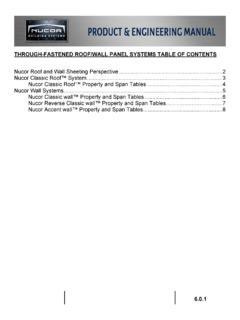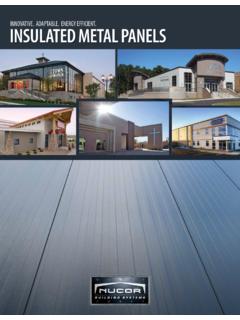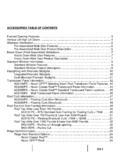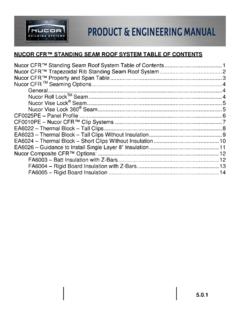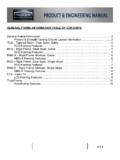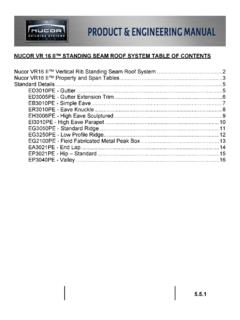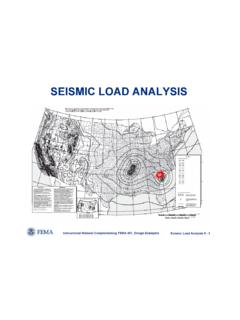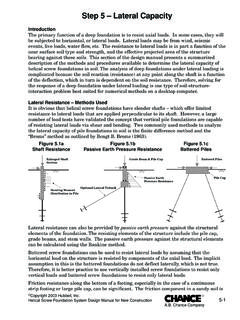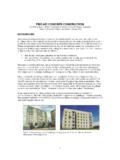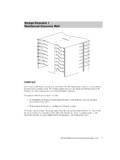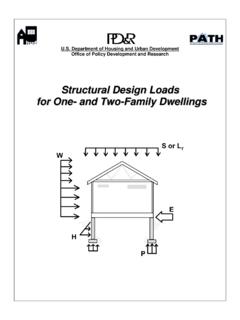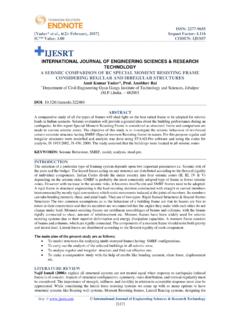Transcription of BRACING SYSTEM TABLE OF CONTENTS - Nucor …
1 SYSTEM TABLE OF CONTENTSB racing Information .. 2 Standard Longitudinal BRACING Height X- BRACING ..3 Torsional X- BRACING ..4 Portal Frame .. 5 Fixed Base Corner Base Endwall Columns ..7 Shear 8 Standard Lateral BRACING Options ..9 Full Height Endwall X- BRACING ..9 Endwall Roof X- BRACING ..9 Brace Detail for Sidewall Wind REVISIONDATE: 03/10/15BY: AAJ CHK: INFORMATIONThe following information is intended to provide general guidelines regarding longitudinal BRACING and lateral endwall BRACING options.
2 For specific questions related to individual projects please contact your engineering team for LONGITUDINAL BRACING OPTIONSL ongitudinal BRACING is a required part of the building SYSTEM , resisting forces due to wind, earthquakes, cranes, and other stability standard product consists of threaded rod or high strength cable used alone or in conjunction with Girts, Purlins, and strut members, to create a truss SYSTEM . Typically, the compressive forces are resisted by purlins, eave struts or girts until the load carrying capacity is exceeded.
3 When axial loads exceed capacities, additional strut members are provided to transfer the axial loads. The chords for the assembled truss typically consist of the primary rigid frame rafters and : For certain loading situations, structural angle may be used in wall BRACING below guidelines are intended to provide guidance for longitudinal BRACING If a roof transverse expansion joint is specified, at least one braced bay must occur on eachside of the expansion joint Field slotting of girts is required for the BRACING to pass through on inset and flush Two-bay and one-bay buildings with Post & Beam endwalls are required to have BRACING inboth endwalls and at least one sidewall.
4 If BRACING is not allowed in the endwalls of this typeproject, the endwall frames must be changed to rigid It is very important that BRACING type and bays where BRACING is not allowed be provided on allquote and order NOT mix BRACING systems along any given wall. For example, Standard X- BRACING andPortal Frames cannot be located along the same sidewall of a Always provide the wall weight for walls NOT by Nucor Building Systems. Examples includeConcrete Masonry Units (Hollow versus Filled), Stucco, Tilt-Up and Pre-Cast Wall Panels, Full Height X- BRACING is the most economical Longitudinal BRACING REVISIONDATE: 03/10/15BY: AAJ CHK: HEIGHT X-BRACINGFull height X- BRACING is the standard Nucor Building SYSTEM solution to longitudinal strength and stability and is the lowest cost option.
5 The below guidelines are intended to provide guidance when utilizing full height X- BRACING . 1. The standard location for longitudinal BRACING is in the first interior bay on buildings three baysor longer. Two bay buildings can have BRACING in either end Standard BRACING is not recommended in adjacent bays, as this causes detailing and Standard rules of thumb for Full Height X- BRACING is shown below:a. Provide one bay of BRACING for every five bays or 150 -0 , whichever is Provide one bay of BRACING for every 80 -0 of building X- BRACING may be relocated to avoid walk doors by providing partial bay (K- BRACING ) based ongeometry For wide modular buildings, X- BRACING should be considered, as it reduces sidewall columnbracing reactions and brace sizes, while adding a longitudinal reaction to the interior columnfoundation at braced bays.
6 Recommendations for using interior column line BRACING include:a. When the width of the modular frame is 220 -0 .b. When full height masonry is used in high seismic regions for modular frames 150 REVISIONDATE: 03/10/15BY: AAJ CHK: X-BRACINGT orsional X- BRACING is an alternative longitudinal BRACING solution that functions with BRACING in only one sidewall, allowing for additional framed openings or horizontal clearances that cannot be met with standard X- BRACING or Portal Frames. When torsional BRACING is utilized, the longitudinal loads acting on the building are resisted by BRACING in one sidewall only.
7 Due to increased forces in the remaining braces and forces introduced into the adjacent rigid frames due to the removal of the sidewall X- BRACING , Torsional X- BRACING is a more expensive and flexible longitudinal BRACING option than full height to the inherent flexibility of Torsional X- BRACING , care should be taken when combined brittle materials and/or large seismic masses. The below guidelines are intended to provide guidance when utilizing Torsional Torsional X- BRACING systems are NOT available in end bays with Post & Beam endwall framingwithout endwall Standard Parameters for Torsional X- BRACING include:a.
8 Low Eave height of building 20 -0 b. Building width 70 -0 c. Building Roof Slope 1:123. Torsional X- BRACING is NOT available for buildings with cranes, mezzanines, or in areas withhigh seismic Sidewall BRACING may be full height X- BRACING or Portal Frame, or partial height Portal Torsional BRACING with Portal Frames is NOT recommended for projects with hardwall REVISIONDATE: 03/10/15BY: AAJ CHK: FRAME Portal Frames are rigid frames that span in the longitudinal direction between primary rigid frames.
9 Portal Frames are an alternative longitudinal BRACING solution that replaces standard X- BRACING in one or both sidewalls with Portal Frames. Portal Frames are options where a desired clear height or clear width must be met in a sidewall bay. Due to their inherent flexibility and greater mass, Portal Frames are a more expensive longitudinal BRACING option than full height below guidelines are intended to provide guidance when utilizing Portal one bay of BRACING for every five bays or 150 -0 , whichever is one bay of BRACING for every 80 -0 of building Width 240 -0.
10 Eave Height 30 -0 . when the required clear height under the BRACING is > 10 -0 . consider Framed Opening heights when considering Portal Frames, especially vertical lift the required clear height is 6 -0 from the eave, a full height Portal Frame will be REVISIONDATE: 03/10/15BY: AAJ CHK: BASE CORNER COLUMNS Another option for the longitudinal BRACING SYSTEM is to provide fixity at the Post & Beam Endwall corner column, known as Fixed Base Corner Columns, as shown above. Fixed Base columns act similar to a flag pole and resist longitudinal movement by deflecting and transferring the longitudinal loads to the foundation which resists the resulting axial, shear, and bending moment.
